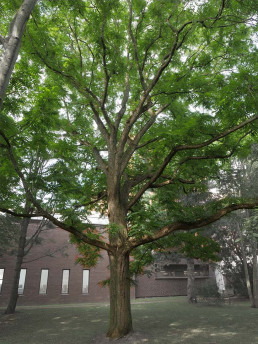The Witness Tree Project | The Witness Trees | Juglans nigra
The Juglans nigra or black walnut is a culturally important species, valued for its ornamentality, high quality wood, and, less commonly, as a source of food [1]. It is also a widely researched species globally, with more than 200 of its features being studied, as retrieved from relevant databases. The specimen at the garden has an individual value, as a fine specimen tree from the collection. Voucher specimens from this tree dating to the 1980s are conserved in Trinity College Herbarium, making it also a good specimen to compare changes in the near past.
1. Valeriu-Norocel, Nicolescu & Rédei, Károly & Vor, Torsten & Bastien, Jean-Charles & Brus, Robert & Benčať, · & Đodan, Martina & Cvjetkovic, Branislav & Andrašev, Siniša & Nicola, · & La Porta, Nicola & Lavnyy, Vasyl & Petkova, Krasimira & Peric, Sanja & Bartlett, Debbie & Hernea, Cornelia & Pástor, Michal & Mataruga, Milan & Podrázský, Vilém & Štefančík, Igor. (2020). A review of black walnut (Juglans nigra L.) ecology and management in Europe. Trees. 34. 10.1007/s00468-020-01988-7.





